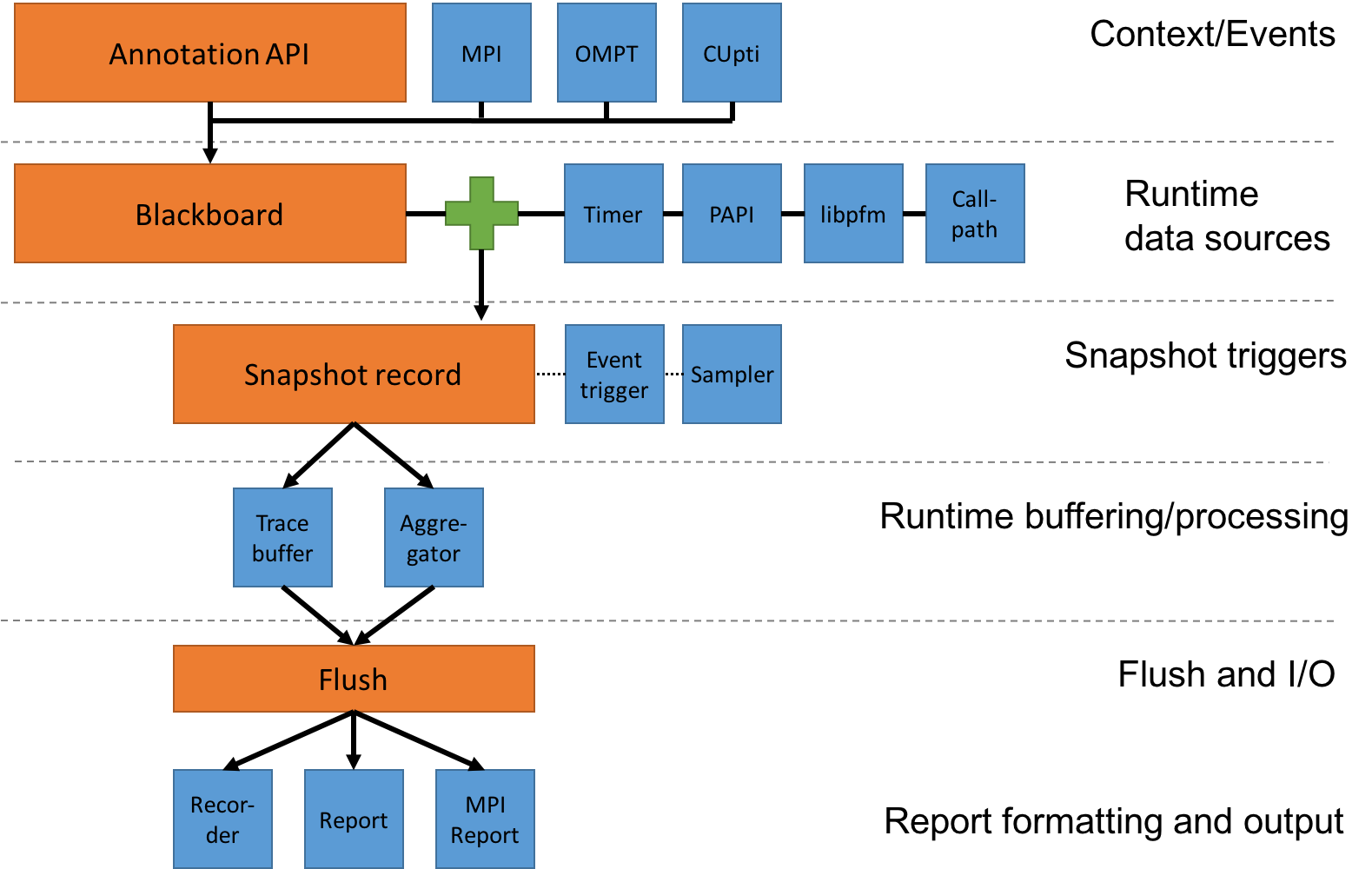Architecture and workflow¶
Caliper’s highly modular architecture allows for a wide range of use cases. For example, it can be used as a library to access application context information from third-party tools, or it can be configured as a stand-alone performance data recorder.
To use Caliper as a performance profiler or trace recorder, we need to set up a data recording pipeline by enabling appropriate services on each pipeline stage. The following figure illustrates the recording pipeline:

Caliper components and the data recording pipeline. The orange boxes are core components of the Caliper runtime library, the blue boxes are services.¶
Caliper services can be used in any combination. However, to produce any output, at least one component must be active in each stage of the recording pipeline.
To activate services, add them to the CALI_SERVICES_ENABLE
configuration variable. The following example activates the event,
trace, timestamp, and recorder services to create an event trace with
timing information for annotated regions (this is the setup of the
pre-defined serial-trace configuration profile):
$ export CALI_SERVICES_ENABLE=event,recorder,timestamp,trace
Caliper warns if the configuration is missing a processing pipeline stage while others are active:
$ CALI_SERVICES_ENABLE=event,timestamp,trace ./examples/apps/cali-basic-annotations
== CALIPER: Config check: Warning: snapshot buffer service "trace" requires offline output services, but none are active.
Add "recorder", "report", "sos" or "mpireport" to CALI_SERVICES_ENABLE to generate Caliper output.
The following sections discuss the pipeline stages in detail.
Context Information and Event Hooks¶
Context information is the key:value data provided by Caliper’s
annotation API. For example, an application can mark a section of code
with the CALI_MARK_BEGIN and CALI_MARK_END macros, or export
any application-specific information that may be relevant for
performance analysis in key:value form with, e.g., cali_set_int.
Context information collection is active for any target program that
contains Caliper annotations and does not need to be configured
explicitly. There are also services that provide additional
context information through the annotation API, for example mpi
(marks MPI functions), ompt (marks OpenMP regions using the OpenMP
tools interface), or cupti (marks CUDA runtime and driver API
calls).
In addition to providing context information, the API calls also serve as hooks for Caliper-internal callbacks. These can be used to trigger snapshots (see below) or connect Caliper annotations to a third-party instrumentation API.
Runtime Data Sources¶
Runtime data sources provide the context and performance data that Caliper records. The primary data source is the blackboard, which contains all information provided by the annotation API. Context information stays on the blackboard until it is explicitly cleared or overwritten (generally, a begin annotation call will put context information on the blackboard, and the corresponding end call will clear it). Hence, the blackboard always contains the current application context as defined by annotation API. The blackboard is always active.
Aside from the blackboard, a number of services provide additional performance or program context data (e.g., timer, PAPI hardware counters, Linux perf events, and callpath). These are not active by default and must be explicitly activated if needed.
Note that enabling runtime data sources only makes them accessible: actual data collection happens through snapshots.
Snapshots¶
Snapshots are Caliper’s mechanism to make performance measurements and collect data. Specifically, a snapshot collects data from all active runtime data sources and creates a snapshot record. The snapshot record thus contains the blackboard contents (with the program context information at the moment the snapshot was taken), along with any data provided by the active runtime data source services (such as timestamps or hardware counter information).
Snapshots can be triggered explicitly through the Caliper API, or by a snapshot trigger service. The two major snapshot trigger services in Caliper are event and sampler (some other services, such as libpfm, can also trigger snapshots). The event service triggers a snapshot on each annotation begin, set, or end event. This allows us to create event-based traces and profiles, collecting exact statistics and performance measurements for annotated code regions. The sampler service triggers snapshots periodically with a configurable frequency. This asynchronous data collection mode is less exact (we may miss some annotated code regions if they are very short), but may incur less overhead. Moreover, in combination with call stack unwinding, sampling can provide basic information about code regions that have not been annotated. Event and sampled snapshot triggers can be active at the same time.
Snapshot Buffering/Processing¶
The snapshot processing stage defines what to do with snapshot records at runtime. Caliper provides two options: tracing and aggregation. The trace service simply stores each snapshot record in an in-memory buffer. The aggregate service performs in-situ aggregation, where only aggregate performance data is kept for different program contexts (e.g., the total runtime spent in each function). This can greatly reduce the amount of data that needs to be kept, especially for long-running, iterative programs.
Flush and Snapshot Post-Processing¶
A flush will push the trace buffer and/or aggregation database contents into the reporting and I/O stage. Flushing can be triggered explicitly through Caliper’s API. Caliper will automatically trigger a flush at program exit.
While the flush itself does not require extra configuration at runtime, we can add snapshot post-processing services in this stage. Notably, the symbollookup service will look up source file, line number, and function name information from binary program addresses provided by e.g. the callpath or sampler service.
Reporting and I/O¶
The final pipeline stage formats and writes the collected records. There are multiple options here.
The recorder service writes records into Caliper-specific
.cali format files (one per process), which can be examined
off-line with the cali-query tool. The report service can
filter, aggregate, and sort output records, and produce JSON output or
human-readable reports in table or hierarchical form. The reports can
be written into files or to standard output. As with recorder,
reports will be written per process. Finally, the mpireport
service aggregates or gathers output records from all ranks in an MPI
program, and writes a single output report. Like report, it can
produce JSON or human-readable output as well as .cali files.
